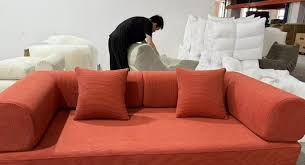Compression sofas are designed to minimize shipping volume without sacrificing comfort or durability. This is achieved through precise engineering, material science, and strict quality control across every production stage. Each step, from foam formulation to final vacuum sealing determines the sofa’s comfort level, rebound speed, durability, and customer experience after unpacking.
Below are the six key stages involved in producing high-quality compression sofas and the standards that guarantee reliable recovery and lasting performance.
- Foam Production and Expansion
Foam is the foundation of any compression sofa, representing more than 60% of total manufacturing costs. It defines comfort, resilience, and longevity. The foaming process must precisely manage chemical balance, density, and curing to maintain stability under long-term compression.
Optimal Foam Density: 28-32D high-resilience foam
Main Components and Reactions:
- Polyether polyol + TDI – main reactants forming polyurethane foam
- Foaming agents (e.g., cyclopentane) – control cell size and elasticity
- Catalysts – ensure uniform reaction speed
- Flame retardants (phosphate esters) – meet EU/US fire safety standards
- Anti-aging additives – prevent hardening or cracking during storage
Process Flow:
- Premixing: Polyol and additives form “Material A”; isocyanate becomes “Material B.”
- High-speed blending: Mix A and B at 2000–3000 rpm (ratio ~1:1).
- Casting: Pour into seat, backrest, and armrest molds.
- Curing: Allow 24 – 48 hours in a ventilated area for full chemical reaction and structure stabilization.
Output: High-resilience foam blocks ready for precision cutting.
- Foam Cutting and Shaping
Once cured, foam blocks are cut into ergonomic shapes that match the sofa’s design. Precision cutting ensures perfect fit and rebound symmetry after compression.
Process Highlights:
- CNC cutting guided by CAD data (tolerance ±1 mm)
- Positioning marks for zippers, buckles, and frame alignment
- Relief grooves to prevent fabric wrinkles during compression
This step ensures every foam section aligns seamlessly with its cover and provides balanced rebound after unpacking.
- Fabric Cutting and Sewing
The sofa’s fabric must withstand compression, resist wrinkling, and remain durable over time.
Fabric Options:
- Cotton-linen blends or polyester-spandex for elasticity and wrinkle resistance
- Optional Teflon coating for water and stain protection
Sewing Specifications:
- Automated cutting with ≤0.5 cm tolerance
- Double stitching using 402 nylon elastic thread (breaking strength ≥50 N)
- Reinforced 3 cm hems for tear resistance
- Heavy-duty zippers with metal teeth and thick zipper tape (tensile ≥300 N)
- Breathable mesh lining with 1–2 cm expansion allowance for rebound
These features ensure the upholstery maintains its shape and quality even after multiple compressions.
- Upholstery and Final Assembly
In this stage, foam components are carefully inserted into their fabric covers to achieve precise fit and smooth lines.
Assembly Process:
- Guided alignment with pre-marked reference points
- Gradual stuffing to prevent fabric overstretch
- Edge smoothing to eliminate trapped air
- Internal fixation (elastic straps or buckles) to prevent displacement
Quality Inspections:
- Seam tension testing
- Surface flatness checks
- Partial rebound simulation to test shape recovery
- Vacuum Compression and Sealing
This is the defining stage that transforms a standard sofa into a “compression sofa.” The goal is to reduce packaging volume by up to 80% while preserving foam integrity.
Process Steps:
- Pre-shaping: Sofa folded into an even, pressure-ready configuration.
- Compression: Hydraulic or roller press evenly compresses the foam.
- Vacuum sealing: High-barrier PE film ensures airtight protection.
- Heat sealing: Locks in vacuum and guards against moisture.
Performance Benchmarks:
- ≥95% shape recovery within 24–48 hours after unpacking
- No seam tearing or zipper failure
- Internal foam structure remains intact and elastic
- Packaging, Storage, and Shipment
After sealing, the compressed sofa is secured for transport and retail display.
Quality Controls:
- Heavy-duty 5-layer export cartons with corner guards
- Protective inner boards for impact resistance
- Humidity-controlled warehouse storage
- ISTA-standard drop and vibration testing
Traceability:
- QR code for batch details (foam density, fabric type, compression date)
- Clear orientation and moisture warning labels
About KINGSEN Foam – Expert in Compression Sofa Manufacturing
KINGSEN Foam is a leading Chinese manufacturer specializing in high-density foam products and compression sofas for over 20 years. Their product range includes modular sectionals, sofa beds, bean bags, kids’ couches, and play furniture.
Offering full OEM & ODM customization, KINGSEN tailors material, color, size, and branding to meet client needs. The company operates a 25,000 m² factory equipped with over 200 advanced machines and a strict ISO9001:2015, BSCI, and IAF-certified quality management system.


Comments are closed.